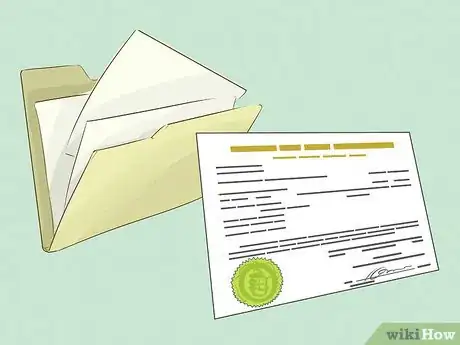This article was co-authored by Clinton M. Sandvick, JD, PhD. Clinton M. Sandvick worked as a civil litigator in California for over 7 years. He received his JD from the University of Wisconsin-Madison in 1998 and his PhD in American History from the University of Oregon in 2013.
There are 9 references cited in this article, which can be found at the bottom of the page.
wikiHow marks an article as reader-approved once it receives enough positive feedback. In this case, 92% of readers who voted found the article helpful, earning it our reader-approved status.
This article has been viewed 239,699 times.
Turning a modern blended family from "yours, mine, and ours," into simply "ours," can be accomplished through stepparent adoption. Through this procedure, the biological child of one of the spouses becomes the legal child of the other spouse. After the adoption, there is no difference in the legal status between children of another marriage and the birth children of the marriage. The word "stepchild" disappears into irrelevance.
Steps
Preparing for Your Adoption
-
1Discuss this decision as a couple and a family. In the rush of happiness, it may not seem like there is any downside, but a stepparent adoption is a monumental change for your family. This adoption will legally remove one of the child's biological parents from his/her life, give him/her a new name, and transform his/her stepparent into his/her legal mom or dad. [1] This is a huge change psychologically for the child. For the biological parent, it means agreeing to give legal rights to the child over to a new spouse.
- Consider sessions with a family counselor. This helps to make sure everyone understands what a stepparent adoption means to the family, and helps ensure it's what the child wants.
-
2Understand the legal ramifications. A stepparent adoption has permanent legal consequences for the biological parent, the adopting parent, and the child.[2] You need to understand and accept them. Consult with an attorney if you have any questions.
- The biological parent needs to know that this adoption makes your current spouse the child's legal parent. If you divorce, your spouse has the right to visitation and even custody. If you remarry again and want the new spouse to adopt your child, you will be seeking the consent of the adoptive parent, not the biological parent.
- The adopting parent takes on all legal rights and responsibilities of parenthood. If you divorce, you will be required to pay child support for your adopted stepchild. Your adopted child gains the right to a share of your estate, even if that lessens the share that goes to your biological children.
- The child forfeits all claims to inheritance from previous family. The absent parent, grandparents, and other relatives of the parent who gave up rights in the adoption may make voluntary gifts to the child, but there is no standing to contest a will or claim a statutory share of the estate.
Advertisement -
3Assemble your documents. At a minimum you will need a certified copy of the child's birth certificate, your marriage documents, and the biological parents' divorce documents (if they were married.) If the absent parent is deceased, you should get a certified copy of the death certificate.
- If the non-custodial parent is living, you will need an address for service of the petition. If you don't have an address, you need to make honest efforts to find it. The minimum efforts the court will expect include Internet searches, contacting his/her family, looking in phone directories, and reaching out to former friends. Document these efforts in a journal so you will remember them.
-
4List the child's property and collect documentation. When you become an adoptive parent, you may gain rights in the child's property. This can include Social Security payments, military survivor benefits, trust funds gained through inheritance, awards in lawsuits, land or other tangible property that belongs to the child. This must be declared in the adoption petition.
-
5Decide if you need a family law attorney or will represent yourself. If the absent parent is willing to consent to the adoption or is deceased, the stepchild adoption procedure is fairly straightforward, and you may be able to do it yourself. If the other parent won't consent, consider consulting with a family law attorney before you file the adoption.
-
6Research the adoption fees. There will be a filing fee to apply to the court to adopt your stepchild. Those fees may be nominal (as low as $20 in California), to over $300 in Texas. Payment will be required at the time you file the petition. Other costs could include an adoption home study, attorney's fees for the child's attorney, criminal history checks, court-mandated counseling, and fees for a new birth certificate. Although it varies per state, in total, it typically costs $1500-$2500 to adopt a stepchild, even if you have the other parent's consent, and even if you don't use a lawyer (because one will often be appointed for the child).
- All courts have a process for waiving some or all of the filing fees. It is dependent on your family income and assets. Ask the court clerk for the procedure in your local court.
Filing Your Adoption
-
1Complete your adoption petition. The petition is the legal document you will file with the court requesting the judge to allow you to adopt your stepchild. If there is more than one child, you can adopt them all at once with the same petition. An adoption petition is a precise document that must be tailored to your state. Missing a detail or not using the right forms can cause problems for you and the child later on. Therefore, it's not recommended that you write your own from scratch unless you have legal training. There are several options for the preparation of your adoption petition.
- Ask the court clerk if they have a fill-in-the-blanks stepparent adoption package. These forms will have been vetted for accuracy and accepted by the court before in adoptions. Expect the cost to be around $10.
- Contact your local Legal Aid office to see if they have a do-it-yourself stepparent adoption package. The forms have been reviewed by an attorney and will comply with local requirements. Expect the cost to be from free-of-charge to under $10. [3]
- Hire a local legal document preparation service or attorney who offers unbundled legal services. The cost can range from around $50 to $200 depending on the jurisdiction. This is a good option if you are petitioning the court for a stepparent adoption and you do not have the explicit consent of the absent parent.
- Once complete, you will file your petition, with the fee, in the courthouse of the county where you have lived with the child for at least six months. You must file in your county of residence, even if another courthouse is closer.
-
2Obtain the consent of the non-custodial parent. This can either be the easiest part of the adoption process or the hardest. Your adoption package will have a form the absent parent can sign and have notarized to indicate their consent. If (s)he is willing to sign, the adoption can usually proceed with no difficulty.
- Once the adoption is complete, the non-custodial parent is freed from all further child support obligations. Past due support can still be collected, but no further support will accrue. [4]
- If the other biological parent is deceased, this will be noted in the petition and a certified copy of the death certificate attached.
-
3Adjust your adoption strategy if the other parent won't consent. There are two common scenarios where you can't get consent from the other parent. First, is that the absent parent is hostile toward the idea and refuses to consent. The second is when the absent parent is truly absent and you don't know how to contact him/her.
- If you believe the adoption will be hostile and contested by the other parent, you should consult with an attorney before you proceed. A non-cooperative parent seriously complicates the procedure and may result in a trial. Unless you have specific legal training and experience, the trial could not only result in denial of your adoption, but a challenge to the custodial spouse's rights of custody.
-
4Attempt to locate an absent parent. If you do not have contact information for the absent parent, there is an extra set of steps you will have to go through. It is highly recommended that you consult with an attorney to make sure you know your state's requirements for dealing with a non-involved and missing parent. [5]
- State laws vary, and it is critical that you follow the law in your state. A good general rule is that if your child has not heard from his/her other parent for over a year, and there has been no financial support for over a year, then the court will grant your adoption.[6] However, this is only a general rule. Local rules vary tremendously.
- You should make a reasonable good faith effort to locate the other parent. Reach out to family and mutual friends. Search the Internet and phone directories. [7] Some states have a "putative parent directory," where people trying to locate their children register. Document your efforts. If the judge does not believe that you were diligent, the adoption will be delayed or even dismissed.
-
5Seek permission for service by publication. If your efforts to locate the absent parent fail, you can ask the court for permission for service by publication. This means that the notice will be published in whatever newspaper is most local to the biological parent's last known address. After service by publication, you can proceed with the stepparent adoption. If your court does not have a prepared form for this request, consult an attorney, document preparation service, or local Legal Aid for help.
- Once the judge grants permission for publication, go to the newspaper in your county authorized to print legal notices. They will help you prepare the notice for the newspaper and give you proof of publication according to your state law. The fee will be around $100 and cannot be waived by the court. [8]
Processing and Finalizing Your Adoption
-
1Attend the preliminary court hearing. After the service period has expired, there is usually a preliminary court hearing where the judge will review the documents, note any deficiencies, and schedule the next step in the adoption.
- This is the absent parent's opportunity to appear. If (s)he does appear, you can either talk to him/her about consent or consider your next move if (s)he refuses. If the absent parent does not appear, you are not required to give him/her any further notice. You are also not required to make any further attempts to contact him/her unless explicitly ordered to by the judge.
- Be sure to comply with any orders issued by the judge. If the court wants additional documentation or information, supply it as soon as possible without question. If the judge orders criminal background checks, you may be required to meet with a court officer and sign a release so they can get your information.
-
2Prepare for a home study. While home studies are usually waived in stepparent adoptions, judges still have the authority to order them. Home studies are conducted by child protective services (or whatever that agency might be called in your state). Cooperate and put your family's best foot forward by welcoming the social worker into your home and answering all of his/her questions. [9]
- The court has the discretion to order a criminal background check on the adopting parent. If the adopting parent has a record of charges involving child abuse or neglect, or his or her own history of back child support or abandonment, the court will be much more unlikely to grant the adoption.
- The judge may or may not want to meet the children. This is completely up to the judge. Some judges do not allow young children in the courtroom at all. It is best to have child care arranged before the court hearing. Ask the judge if (s)he wants you to bring the children to the final hearing.
- If your child is over a certain age--usually fourteen--then the judge will have to get his or her consent in order for adoption to proceed, as well.
-
3Attend the final court hearing. At this hearing, the judge will make his/her ruling on your stepparent adoption. This is also the last chance for the absent parent to appear. The judge will review the documents and ask you about your intent to adopt the child. (S)he will also ask your spouse if (s)he consents to your adoption of his/her child and changing the child's last name. If the children are present, the judge may talk to them. Upon signing of the order, you become the legal parent of your stepchild.
- You may be scheduled during the regular court docket. Even though this is a joyous time for you, the court may have other business to conduct. Definitely don't bring a large group, cameras, balloons, or anything else that may interfere with court operations. Judges are not a group of people known for their joviality. Save the party for later.
- Some courts schedule special "adoption dockets" that are more relaxed and festive. At these special settings, judges will usually allow photos and a party-like atmosphere.
-
4Change your child's birth certificate. Upon receipt of the file-stamped adoption order you can file for a new birth certificate showing your child's adopted name and proceed with updating school and medical records.
References
- ↑ https://www.ohiobar.org/forpublic/resources/lawyoucanuse/pages/lawyoucanuse-204.aspx
- ↑ http://life.familyeducation.com/stepfamilies/adoption/47620.html
- ↑ http://www.lsc.gov/find-legal-aid
- ↑ http://cssd.dc.gov/page/changes-custody
- ↑ https://www.uakron.edu/dotAsset/2d92dcad-4ce1-4861-9626-3542a109d26a.pdf
- ↑ http://www.yelman.com/divorce-library/stepparent-adoption/
- ↑ http://www.investigatorconfidential.com/02-find-a-missing-person.htm
- ↑ https://probatejuvenile.clermontcountyohio.gov/wp-content/uploads/sites/42/2018/01/19_7s.pdf
- ↑ http://www.friendsinadoption.org/adoption-resources/for-potential-adoptive-parents/adoption-home-study/
About This Article
To adopt your stepchild, start by gathering documents you need, like the child’s birth certificate, your marriage documents, and the biological parents’ divorce certificate if they were married. Once you’ve located the relevant documents, ask your local court clerk for a fill-in-the-blank adoption petition and fill in your details. At this point, you should also get the child’s non-custodial parent to sign the document if they’re still alive. After you’ve filed your adoption petition and paid the relevant fees, you’ll need to attend 2 court hearings. If the judge orders a home study, make sure your house is in order to prove the environment is healthy for your child. Once the judge passes your adoption order, file for a new birth certificate with your name on it. For more tips from our Legal co-author, including how to adopt your stepchild when you can’t contact their biological parent, read on!









































































